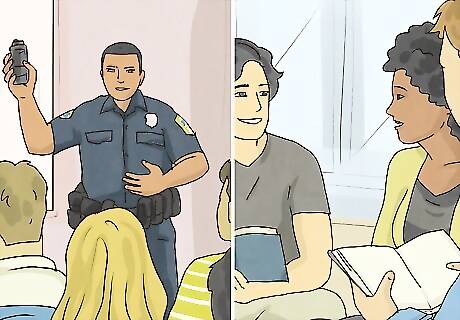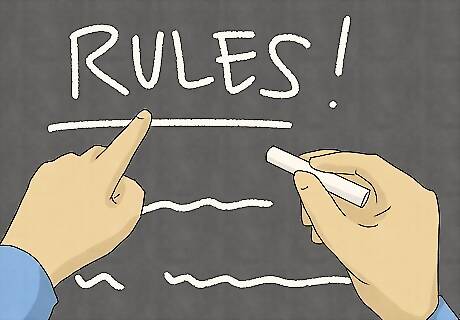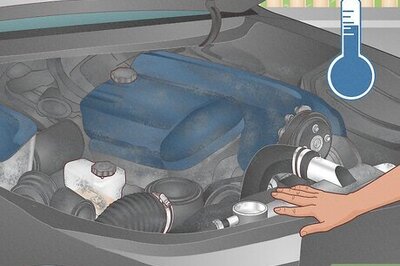
views
Setting a Positive Example

Always be positive. The most important tool in creating a positive classroom atmosphere is for the teacher to be a consistent role model. Being positive doesn’t mean being happy all of the time. Rather, it means approaching every issue with a positive, constructive attitude. There are little ways to be positive, such as smiling in the morning when your students arrive. You should also be positive when difficult issues arise. For example, if a scary news story comes up in class, talk about things the students can do to help. Or discuss how it’s okay to be sad and no one should be looked down upon for expressing their emotions in a healthy way.

Model good social skills. Your students will mimic the behavior that you display. If you react with anger when a student misbehaves, your students will think this is the right way to respond to frustration and they will do the same. On the other hand, if you display self-control in the face of frustration, your students will do the same. Important positive social skills include empathy, tolerance, patience, and effective communication. As an example of good communication and patience, if a student is disrupting the class, don’t ignore the behavior and then suddenly lash out with anger. Instead, calmly ask the student to respect the class’s time. If the student continues to be disruptive, tell them that you need to send them to the office and you’ll be down later so the two of you can discuss the problem. You can also praise students when they display good social skills and point out their behavior as a model for the rest of the class.

Use strong role models. Integrate role models from the community into your classroom. The more role models from different walks of life your students see, the more they will feel that a good attitude can apply to any situation. Bring in a policewoman or fireman from the community and have them discuss how they approach the difficult aspects of their jobs with a positive attitude. Include ordinary people. Invite a sales clerk and a waitress to talk about how they deal with difficult customers and challenges of working in the customer service field.
Using Positive Reinforcement

Acknowledge positive behaviors. If you point out good examples of positive behavior, your students will learn to recognize these behaviors and seek to emulate them. Encourage your students to aspire to these role models. When a student engages in a positive behavior such as helping another student or peacefully resolving a conflict, acknowledge the behavior by either bringing it to the individual student’s attention or to the attention of the entire class. For example, if a student steps in to support a student who is being bullied, you might acknowledge the student later and say, “This is the kind of positive behavior that helps make everyone feel happier and more comfortable.”

Praise positive behaviors. Praising your students when they engage in positive behaviors provides a positive reinforcement for the behavior beyond simple recognition. It lets the student know that they’ve done a good job and helped the class move in a positive direction. In order to be effective, praise should be specific, sincere, and culturally-appropriate. For example, if a student writes a good paper, praise the student’s specific use of lesson material (“Excellent job segueing from the introduction to the body of your paper”), make sure the praise is sincere, and don’t praise the student in front of the class if it will make them feel uncomfortable. It’s important to praise effort as well as outcomes. If a student is trying hard to accomplish a task, praise their efforts and encourage them to keep trying.

Encourage your students to encourage each other. Positive reinforcement doesn’t have to come from you alone! Tell your students to compliment one another when they notice positive behaviors. You can also incorporate peer feedback into your classroom. For instance, ask students to give feedback on another student’s presentation. EXPERT TIP Joseph Meyer Joseph Meyer Math Teacher Joseph Meyer is a High School Math Teacher based in Pittsburgh, Pennsylvania. He is an educator at City Charter High School, where he has been teaching for over 7 years. Joseph is also the founder of Sandbox Math, an online learning community dedicated to helping students succeed in Algebra. His site is set apart by its focus on fostering genuine comprehension through step-by-step understanding (instead of just getting the correct final answer), enabling learners to identify and overcome misunderstandings and confidently take on any test they face. He received his MA in Physics from Case Western Reserve University and his BA in Physics from Baldwin Wallace University. Joseph Meyer Joseph Meyer Math Teacher Take satisfaction in seeing your students thrive. Celebrate your students' "aha!" moments and enjoy witnessing their progress. Appreciate when they buy into the collaborative learning environment you've been fostering. These rewarding moments are the fuel that will uphold your passion for teaching.

Avoid negative reinforcement. Negative reinforcement involves punishing undesirable behaviors instead of praising desirable behaviors. Negative reinforcement, used alone, tends to build resentment and distrust between the student and teacher, and lowers students’ self-esteem. Substitute positive reinforcement for negative reinforcement whenever possible. For example, if you have an unruly student, make a concerted effort to use positive reinforcement techniques when the student behaves well instead of only calling them out when they behave badly. If you do need to discipline a student, do so privately so as to avoid embarrassing them. This will let the student know you respect them as a person even though you’re upset with them at that moment.
Building Trust

Get to know your students. Your students will be more inclined to act in positive ways if they feel like their teacher cares about them as individuals. To build relationships with your students, interact with them in informal situations such as before and after class, and use instructional methods that encourage them to share their personal views and experiences with the class. For example, before class, stand by the door and greet each of your students by name as they arrive. On Monday mornings, ask them to share something fun they did over the weekend. EXPERT TIP Joseph Meyer Joseph Meyer Math Teacher Joseph Meyer is a High School Math Teacher based in Pittsburgh, Pennsylvania. He is an educator at City Charter High School, where he has been teaching for over 7 years. Joseph is also the founder of Sandbox Math, an online learning community dedicated to helping students succeed in Algebra. His site is set apart by its focus on fostering genuine comprehension through step-by-step understanding (instead of just getting the correct final answer), enabling learners to identify and overcome misunderstandings and confidently take on any test they face. He received his MA in Physics from Case Western Reserve University and his BA in Physics from Baldwin Wallace University. Joseph Meyer Joseph Meyer Math Teacher Show students you care. Observing your students allows you to tailor your teaching to their needs. Over time, you'll be able to deepen their understanding of the subject matter. Students appreciate teachers invested in their growth, and building long-term relationships with students is incredibly rewarding.

Share your life with your students. Building relationships is a two-way street. In addition to showing an interest in your students’ lives, you should share aspects of your life with your students as well. This will help your students feel like they know you as a person and not just as an authority figure. You should share details of your life but avoid oversharing. For example, if you return from a vacation with friends you might talk about the places you visited, but avoid talking about drinking or partying.

Use humor. Humor is essential for building a positive atmosphere. Humor helps your students feel comfortable and at-ease in your classroom. Incorporate humor into your lesson-plans and use it everyday. One good way to include humor in your lessons is to preface each lesson with a cartoon. If you look through comics like the Far Side or Calvin & Hobbes you can find scenarios that match almost any lesson plan! Make sure to keep your humor positive and avoid sarcasm.

Hold class meetings. Class meetings give students a sense of ownership over their situation. Make time for a weekly class meeting where students can freely discuss what it means to have a positive classroom atmosphere. Begin the meeting with a discussion question like, “Why is it important to respect other people’s cultures?” How can students include others in activities? Use your authority as a teacher to moderate discussions. Encourage positive, constructive discussion.

Teach and enforce rules. Your students will feel more secure, positive, and trusting if they know what is expected of them in your classroom. Make the rules easy to understand. For example, instead of having a rule that says “maintain an orderly atmosphere,” have a rule that says “stay in your seat when the teacher is talking.” Allowing your students to help craft the rules is a good way to give them a sense of ownership and responsibility for the classroom.

Give every student responsibility. When your students have responsibilities in the classroom they will feel more personally invested in maintaining a positive atmosphere. Make sure every student has responsibility for some aspect of the classroom. For example, if you have a class pet, you could have one student responsible for feeding it and another student responsible for keeping the cage clean. Be careful not to give a few students a lot of responsibility and other students very little responsibility. If there aren’t enough tasks to go around, rotate what students are responsible for what tasks on a weekly basis.

Incorporate a variety of skills into class activities. It’s important to strive for a balance of activities in the classroom so that students with different interests will stay engaged. Planning activities in which students use different skills helps them relate positively to the material. Some activities should focus on introspection, while others should be more extroverted. You can also incorporate different subjects into your lesson, no matter what class you teach. For example, try to incorporate art into a science lesson or geography into an English lesson.

Keep your classroom organized. Students tend to feel more positive, productive, and trusting in clean, organized environments. Taking a few minutes every day to straighten up can go a long way to maintaining a positive environment in your classroom. Store supplies in easy-to-find bins with labels. For example, you might keep all of the coloring supplies in a purple bin and all of the construction toys in a yellow box. Let your students help organize the classroom. This will give them an extra sense of ownership over their environment and they’ll feel invested in keeping it in order.


















Comments
0 comment